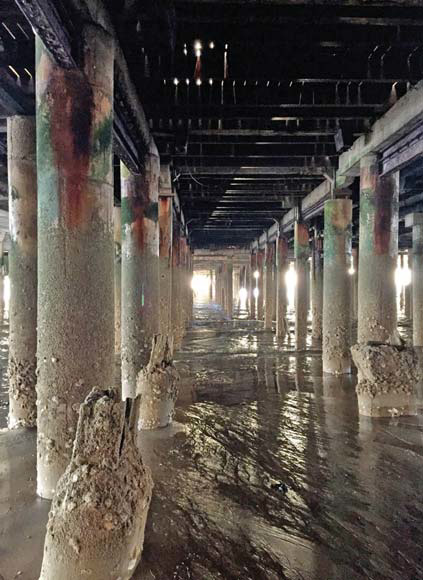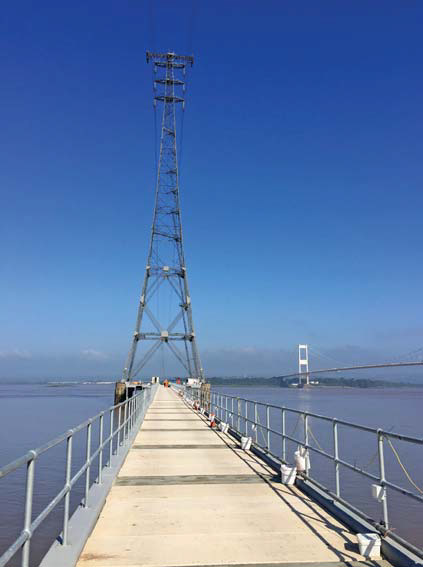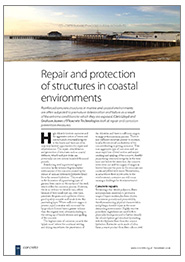Reinforced concrete structures in marine and coastal environments are often subjected to premature deterioration and failure as a result of the extreme conditions to which they are exposed. Chris Lloyd and Graham James of Flexcrete Technologies look at repair and corrosion prevention measures.
 High chloride levels in seawater and the aggressive action of waves and currents push structural integrity to the limits and there are oftenonly very limited opportunities for repair and refurbishment. The repair, rehabilitation and protection of structures such as coastal defences, wharfs and pier decks can potentially run into several hundred thousand pounds.
High chloride levels in seawater and the aggressive action of waves and currents push structural integrity to the limits and there are oftenonly very limited opportunities for repair and refurbishment. The repair, rehabilitation and protection of structures such as coastal defences, wharfs and pier decks can potentially run into several hundred thousand pounds.
Reinforcing steel is protected against corrosion by the inherent highly alkaline environment of the concrete created by the release of calcium hydroxide (hydrated lime) from the cement hydration. This results in the formation of a passivating layer of gamma ferric oxide on the surface of the steel, which stifles the corrosion process. However, this is no defence to chloride ions, which because of their small size can, over time, penetrate the pores and capillaries of even good-quality concrete and break down this passivating layer. Where sufficient oxygen is present, rapid corrosion will occur and the by-products formed have a greater volume than the original steel, ultimately leading to the setting up of tensile stresses and spalling of the concrete.
The highest rates of corrosion occur in the ‘splash zone’, where the continual wetting and drying exacerbates the penetration of the chlorides and there is sufficient oxygen to support the corrosion process. There is also sufficient moisture present to increase, locally, the electrical conductivity of the concrete leading to pitting corrosion. This is an aggressive type of corrosion and can cause rapid loss of steel section and major cracking and spalling of the concrete, thereby jeopardising structural integrity. In the tidal zone and below the water line, the concrete never dries out and the supply of oxygen is limited because the pores in the structures are continually filled with water. Nevertheless, in areas where there is low cover to the reinforcement, corrosion can still occur, causing a challenge for its reinstatement.
Concrete Repairs
Technology that blends polymers, fibres and pozzolanic materials to produce a range of repair mortars, has been shown to minimise porosity and permeability, thereby maximising physical characteristics and giving a durable repair in the most demanding environment. Highly reactive pozzolanic ingredients are used both to physically block pores and to further densify the silicate hydrate gel structure by reacting with the hydrated lime from the cement hydration. Extensive use is made of silica fume, a waste product from ferro-silicon steelproduction, which is 100 times finer than Portland cement and almost five times more reactive. Research has shown that not only does silica fume refine the pore structure on the macro scale but also it has excellent chloride ion binding capacity and produces a cohesive mix, which has excellent washout resistance.
The inclusion of long chain cellulosic polymers chemically combines the gauging water into the mortar, which enhances the rheology and water retention to improve washout resistance, enabling spray and hand application in onerous tidal areas. The inclusion of a thermoplastic resin, in the form of an advanced styrene acrylic copolymer, imparts greatly enhanced adhesion and resistance to abrasion and chemical attack, as well as physically blocking pores and capillaries to densify the matrix. Independent tests show that the repair materials are not only highly waterproof, resisting water penetration even under 10 bar hydrostatic pressure, but also have high diffusion resistance to oxygen.
Protective Coatings
This technology is also available in a range of cementitious coatings, which can be spray or brush applied at 2mm thickness to saturated concrete in the harshest marine environment. They exhibit excellent washout resistance and can withstand immersion as little as 60 minutes after placing, curing under water to provide a dense, durable coating. Independent tests have shown that a 2mm coating is impermeable to water under a hydrostatic head of 100m and will form a complete barrier to chloride ions. High diffusion resistance to oxygen will minimise the fuels for corrosion such that a 2mm thickness is equivalent to 100mm of good-quality concrete cover.
Case Studies in Action
Aust Jetty
Extensive repairs were required to Aust Jetty, a jetty in the River Severn. Built in the 1960s, the trestle-type reinforced concrete jetty supports and gives service access to a transmission tower downstream of the Severn Bridge at Aust. The tower is one of two that span the Severn Estuary and are taller than a 53-storey block, making them the second highest in the UK. Large-scale concrete repairs were required to the legs of the jetty, plus the main platform. This was a challenging project in a testing environment, as large sections of the plinths are submerged for long periods of time, meaning that only a limited time frame was available to place concrete repair materials and allow them to set. It was also important that once in place, the materials were not adversely affected by immersion. Anti-carbonation protection was required on the top section of the jetty, plus levelling and anti-slip deck protection was needed on the main platform to allow maintenance work to be carried out safely.
Once the defective concrete was cut out of the legs of the jetty by application contractor QST, a cementitious protective coating was applied to the steel reinforcement prior to the application of a waterproof, Class R4 structural repair mortar. Able to be applied up to thicknesses of 80mm in a single application, the mortar exceeds the tensile strength of concrete and its dense matrix offers low permeability to water, even at 10 bar pressure. An anti-carbonation coating was applied to the top section of the jetty and a two-component, epoxy and polymer-modified waterborne cementitious levelling screed was then used to level the jetty platform. Grit was cast into the levelling coating to provide anti-slip protection, so that operatives carrying out maintenance are not at risk of slipping in the hazardous conditions.
Clacton Pier
Clacton Pier is located in the seaside resort of Clacton-on-Sea. First opened to the public in 1871, it was originally used as a landing point for goods and passengers, as well as a docking point for steamships. By 1893, Clacton had become such a popular destination for day trippers that the pier was lengthened to 1180ft (360m), almost three times theoriginal length, and entertainment facilities were added. The Clacton Pier Company acquired the pier in 2009 and it now boasts a variety of indoor and outdoor entertainment.
Much of the pier has remained untouched for 90 years or so and as part of a seven-figure makeover, work is being carried out to modernise and strengthen the landmark’s infrastructure. The pier is supported by 2500 reinforced concrete columns and beams, which were showing signs of chloride attack from years of tidal salt-laden seawater. An effective refurbishment solution was required and sustainability was a key issue in making the 146-year-old structure relevant to today’s leisure needs.
The refurbishment work is being carried out by Clacton Pier Company’s own maintenance team using Flexcrete’s water-based concrete repair materials to meet the sustainability requirements of the project. A specification for the structural renovation work has been devised, which comprises a corrosion-preventative flexible coating for steel reinforcement, followed by a waterproof mortar that can be applied up to 80mm in a single application. The columns and beams are being finished with a fairing coat to reinstate cover and provide a waterproof and anti-carbonation finish. The final protection overall is with a cementitious coating, which provides structural waterproofing and importantly protection from future chloride ingress. With some 2500 columns to be refurbished, this is a long-term project that is likely to extend over several years to come.
St. Peter Port Docks
St Peter Port Docks are located in the capital of Guernsey, one of the main Channel Islands situated off the coast of Normandy. An essential part of the island’s infrastructure, a detailed assessment of the quay structures was carried out to take into account revised loading conditions and to extend the service life of the assets. The assessment revealed that extensive repair work was required to the reinforced concrete and steel structures, as well as the design and installation of cathodic protection systems to enhance durability in the severe marine environment. The contract formed part of one of the largest marine repair and cathodic protection systems ever installed in Europe.
Part of the works involved chloride protection of concrete-encased steel columns located in a 10m tidal zone. The columns were initially protected with a 75mm-thick concrete overlay but the client wanted to increase the protection and durability. A cementitious coating was chosen to provide waterproofing and effective protection against chloride attack. Rapid application of the coating was vital for this project due to the location of the columns in the tidal zone. The coating, which is independently proven to provide at least 29 years’ protection against chloride attack, was quickly applied by contractor Concrete Repairs Limited using spray techniques at a thickness of 2mm, rapidly stabilising to resist wash out on early immersion to produce a durable and hard-wearing protective coating. The cementitious coating has helped ensure that the structure will achieve a design life of at least 25 years.
To download the full article please click on the link below:





